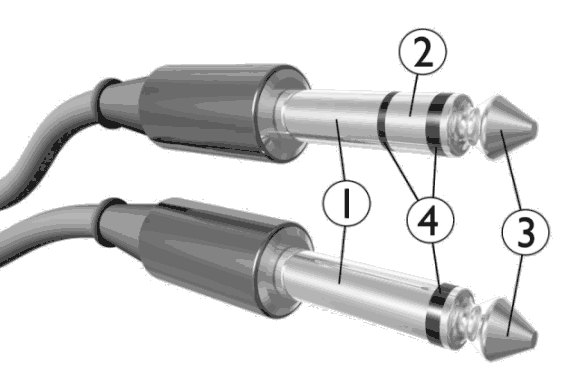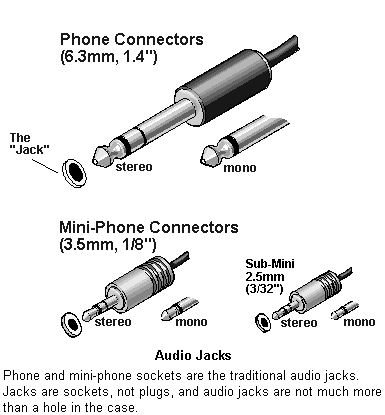TRS Phono Plug
The audio jack that is commonly seen on stereo headphones, audio devices such as the iPod, and many cell phones is known as the TRS Connector. The TRS phono plug connector is an audio jack with either 2 or 3 rings. TRS is an acronym representing Tip + Ring + Sleeve. The 2 ring version is for mono audio and the three ring version is for stereo audio. There are also other variants such as a four ring version which is often designed for camcorders, the extra ring for the video signal.
Contents
Divisions
The divisions of the plug in phone, mini-phone and sub-mini connectors that represent the different conductors. Tip (T) and ring (R), along with the sleeve (S), are used in two-conductor (TS), three-conductor (TRS) and four-conductor (TRRS) variations.
Polarity
- 1. Sleeve: usually ground
- 2. Ring: Right-hand channel for stereo signals, negative phase for balanced mono signals, power supply for power-requiring mono signal sources
- 3. Tip: Left-hand channel for stereo signals, positive phase for balanced mono signals, signal line for unbalanced mono signals
- 4. Insulating rings
Tip
The tip is normally left - as left is conventionally follows mono as regards wiring convention.
Theory of Stereo Mono Conversion
Shorting leads to create a mono signal has been used for the past 50 or so years with headsets. The stereo plug has a tip, ring and sleeve section while a mono headset will have only a tip and sleeve. When the mono headset is plugged into a stereo jack, both ring and sleeve contacts the sleeve section of the mono plug thus combining the two channels into a mono signal.
Headsets with a mono/stereo switch also combine the channels by shorting the two hot leads.
The signal is invariably on the tip of the plug, and the metallic sleeve closest to the body of the plug is the shield/ground.
However, the RadioShack 274-378 1/8" Stereo Male to RCA Female adapter combines (2) ring and (3) tip to go from a stereo phone to a mono RCA connector. This contracts to inserting a mono plug into a stereo jack, where as the (1) ground sleve would be combined with the (2) ring via the absent of the ring on the mono TS (Tip + Sleeve) plug. So where should the (2) ring audio channel really go? With the sleeve ground or the left phase tip?
There are different types of stereo-mono adapters. Depending on their genders and how they interface between the two-conductor tip-sleeve plug on the mono end and the three-conductor tip-ring-sleeve plug on the stereo end, the adapter may just be shorting right to ground and passing a left signal (as would happen if you plugged a mono headphone plug into a stereo jack).
Mono Jack wiring
Common on musical instruments, stomp boxes and unbalanced microphones
- Tip - signal (Hot)
- Ring - Ground
Stereo Jack Connections
The contacts of a stereo plug are allocated as follows
- Tip - Left channel
- Ring - Right channel
- Sleeve - Common (ground)
Balanced Audio Tip-Ring-Sleeve (TRS) Jack Plug Connections
Often implemented with the professional TRS jack
- Tip - Hot (+)
- Ring - Cold (-)
- Sleeve - Ground
note: The professional TRS jack can be told apart by the fact that the tip and ring metal parts have a smaller diameter than the sleeve, and TRS plugs often have brass contact surfaces. Stereo jacks are usually nickel-plated, so there is a colour difference too. Forcing the domestic stereo jack plug into a professional TRS socket will often bend the contacts of the socket so it does not make good contact in future when mated with a TRS plug.
PC99 computer Audio connections (3.5mm 3 pole jack)
As used on PC sound card microphone inputs (outputs and line inputs follow the regular stereo jack connections above). 3.5mm connectors are used.
- Tip - Mic input
- Ring - +5V supply, (via a limiting resistor usually)
- Sleeve - Ground
Sizes
- 1. Quarter Phono (1/4) - common for band equipment, mixers, DJ equipment, and legacy headphone (studio).
- 2. Mini Phono (1/8) - common for Walkman, portable audio, iPod, modern headphones and some newer mobile phones.
- 3. Sub-Mini Thirty-Second (3/32) - standard for mobile phone audio connector, however, eight is become more common on newer models.

